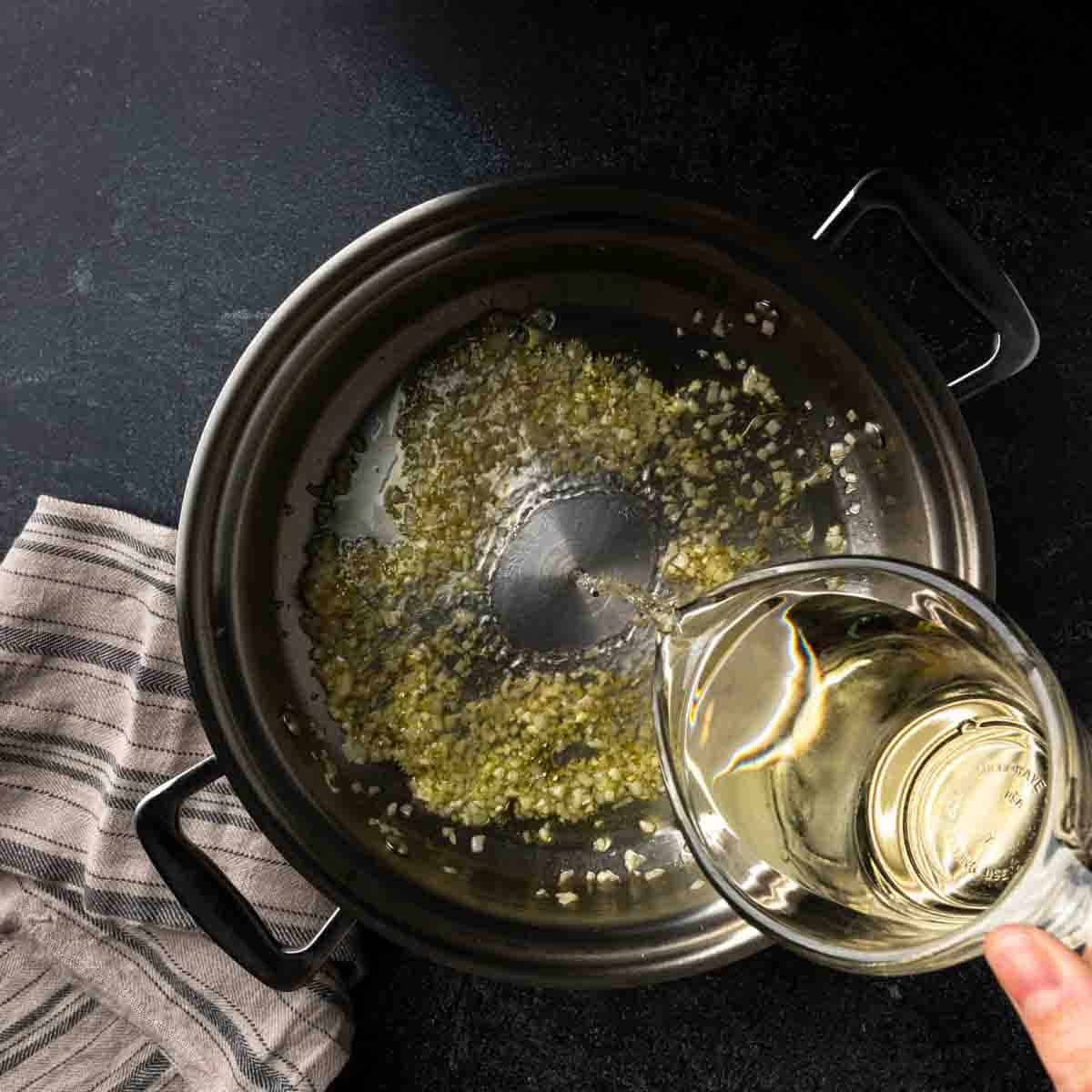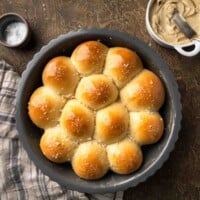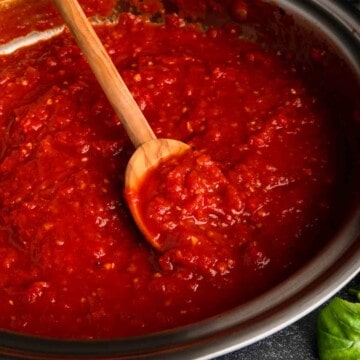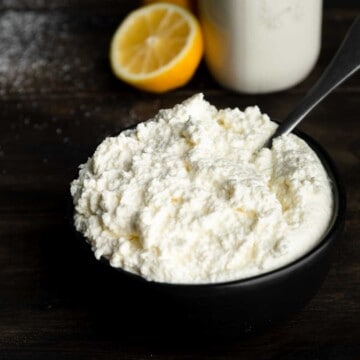This simple white wine lemon butter sauce comes together in under twenty minutes and pairs perfectly with simple pasta dishes, fish, chicken and more! It's my own take on the French classic - beurre blanc, made without heavy cream.

This simple sauce is the perfect pairing for many meals. We love this sauce with shrimp, salmon and white fish, roasted chicken, green vegetables, and simple pasta dishes. It's fabulous on our spinach ricotta ravioli!
Jump to:
Ingredients
This sauce is more or less a beurre blanc. Beurre blanc (meaning white butter) is a classic emulsified butter sauce that is paramount in French cuisine. This version of beurre blanc replaces the classic vinegar with lemon juice and omits the heavy cream (which is sometimes used to stabilize the sauce). It's simple - super bright and lemony with a rich and creamy texture.

- White Wine - Anything dry and drinkable will work but I also prefer something bright and crisp. I recommend using a dry white that that is un-oaked (or lightly oaked.) Muscadet (a crisp white from Loire Valley) is classically used in beurre blanc because it is inexpensive, fermented dry, and has bright acidity, modest fruit and no oak. Other wine that would work well for this recipe include Chablis (mineral-driven French chardonnay), sauvignon blanc or pinot Grigio.

How To Make This Sauce
- In a medium sauce pan, heat olive oil over medium heat. Add shallots and sauté for 2 - 3 minutes or until softened and transparent. Add garlic and sauté an additional 30 seconds to 1 minute.


- Add white wine and lemon juice. Bring to a simmer, stirring occasionally. Simmer until the wine has reduced and there is only about 1 - 2 Tablespoons of liquid left in the pan.


- Remove the pan from the heat. While whisking constantly, add cubes of cold butter one at a time. Allow the butter to melt halfway, then add another cube. Continue whisking while adding the remaining butter. Adjust seasoning, as desired.


- The sauce can be strained to be perfectly smooth or left and served as is. Serve immediately.

Understanding Emulsified Butter Sauces
This beurre blanc style sauce is a delicate emulsion, similar to hollandaise, that must be kept at a certain temperature to avoid separating. (A "broken" sauce refers to a separation of fats and other ingredients.)
Ideally this sauce is made just before serving and kept just around 130° Fahrenheit (the ideal temperature for emulsified butter sauces). The creamy texture of white wine lemon butter sauce comes from tempering the hot sauce with cold cubes of butter.
A Pinch of Sage Science: Why Does it Work? - Butter contains a small amount of lecithin (a type of animal fat) that works as an emulsifier (attracting both fats and water). Constantly whisking the sauce as the butter melts into it helps to scramble the lecithin amongst the ingredients. While whisking, the lecithin attracts the water based ingredients of wine, citrus juice, shallot and garlic while simultaneously attracting the fats from the butter and olive oil.
The result is an emulsion that has naturally thickened and creates a rich and creamy mouthfeel. If the sauce becomes too hot (or too cold), the bonds are broken and the sauce separates ("breaks") into water-based ingredients and fat-based ingredients.
How To Fix a "Broken" Butter Sauce
If your white wine lemon butter sauce separates, the sauce is considered "broken" and it will lose its creamy texture and pretty, cohesive appearance. This usually happens when the sauce is too hot or too cold.
My best advice to avoiding broken butter sauce is to remove the pan from the heat before adding any butter, whisking constantly and preparing this sauce just before you intend to eat it.(Holding the sauce while the other food cooks tends to be a common culprit for broken butter sauces. If you've ever been a line cook during a brunch rush - you know all about the woes of hollandaise and broken butter sauce.)
Troubleshooting
Too Cold - If the sauce is broken from becoming too cold (resting while the rest of the meal cooks) it can likely be revived with a touch of heat. Return the pan to low heat and whisk vigorously. Be careful not to over heat the sauce- the perfect range is 130° Fahrenheit, well below a simmer. If you see any steam or small bubbles forming remove from the heat immediately and continue whisking until smooth.
Too Hot - Cooking the sauce too hot will break the emulsification, as well. While it may seem counterintuitive, a sauce broken from high heat can be revived with a splash of water (or stock). Lower the heat immediately, you may need to take the pan off of the stovetop. Add a small splash of liquid (about 2 - 3 Tablespoons) and whisk vigorously while heating gently, until thick and glossy.
Pro Tip: Serve Butter Sauce on Warmed Plates - To avoid breaking, butter sauce needs to stay warm, even when it's in the plate! (Nothing hurts worse than adding your finishing spoon full of butter sauce, draped perfectly over your dinner, only to watch it separate as it hits the table. Using warm plates can help to keep your sauce tempered and glossy, throughout your meal.

Serving Suggestions
The beauty of this sauce is that is incredibly versatile and can be used to add a little lemony butter flavor to several dishes. It's a bright sauce that is classically used to enhance seafood, vegetables and chicken. Personally, I love it on pasta.
I love serving this sauce with our spinach ravioli recipe. It's wonderful with shrimp scampi, pan seared salmon or to dress up a simply prepared chicken dish.
The sauce is also lovely when served over simple vegetable dishes. White wine lemon butter sauce is lovely on grilled asparagus, broccoli, roasted cauliflower and sautéed spinach, to name a few.

Frequently Asked Questions
Any drinkable dry white wine will work for this recipe. I like to use a dry white that is mineral, bright and crisp. Muscadet, sauvignon blanc, or un-oaked chardonnay are all fine options.
Broken butter sauce is usually caused by temperatures that are too hot or too cold. For the best results, cook over low heat, vigorously whisk in the cold butter away from the heat source and serve immediately on warmed plates.
If needed, you can make this recipe using chicken or vegetable stock instead of wine but it will lack its classic flavor. If substituting the wine, I recommend adding a Tablespoon of additional lemon juice or white vinegar to help bring a balance of acidity to the sauce.
You May Also Like...
Recipe

Lemon Butter Sauce (For Pasta, Fish & More)
ADJUST SERVINGS
Special Equipment
- Fine-Mesh Strainer (Optional)
Ingredients
- 2 Tablespoons olive oil
- 1 small shallot finely diced
- 2 - 3 cloves garlic minced
- ½ Cup dry white wine such as Muscadet, un-oaked chardonnay or sauvignon blanc
- 2 Tablespoons lemon juice freshly squeezed
- ½ Cup butter (1 stick) cold, cubed
- fine kosher salt* to taste
- black or white pepper optional, to taste
Instructions
- In medium sauce pan, heat garlic over medium low heat. Add shallot and sauté for 3 - 4 minutes, or until transparent. Add garlic and cook an additional 1 minute.2 Tablespoons olive oil + 1 small shallot + 2 - 3 cloves garlic
- Add in white wine and lemon juice. Whisk to combine and bring to a simmer, whisking frequently. Simmer until the liquid has reduced and is nearly dry.½ Cup dry white wine + 2 Tablespoons lemon juice
- Remove the pan from the heat. While whisking constantly, add cold butter one cube at a time. When the butter is nearly melted, add another cube. Continue whisking and adding butter until all of the butter has been added and the sauce is smooth, glossy and thick.½ Cup butter (1 stick)
- Season with salt and pepper (if using), as desired. If you would like, you can strain the sauce through a fine mesh strainer. Serve immediately.fine kosher salt* + black or white pepper
- For Serving With Pasta: If serving with pasta, I recommend gently heating the pasta in the sauce. Add the cooked pasta and about ½ Cup of starchy pasta water and stir constantly, for 2 - 3 minutes until the sauce has reduced and has thickened around the pasta.
Notes
* A Note About Salt
Unless otherwise noted, all recipes on The Sage Apron are developed using Diamond Crystal Kosher salt. It is a great all-purpose salt for cooking and baking. If using table salt, reduce quantities by about half.






















Comments
No Comments